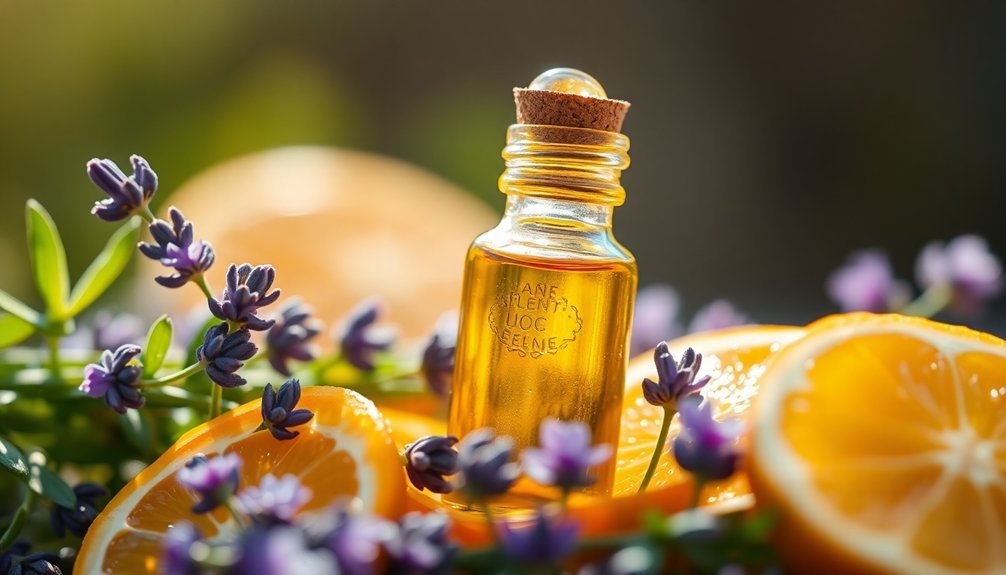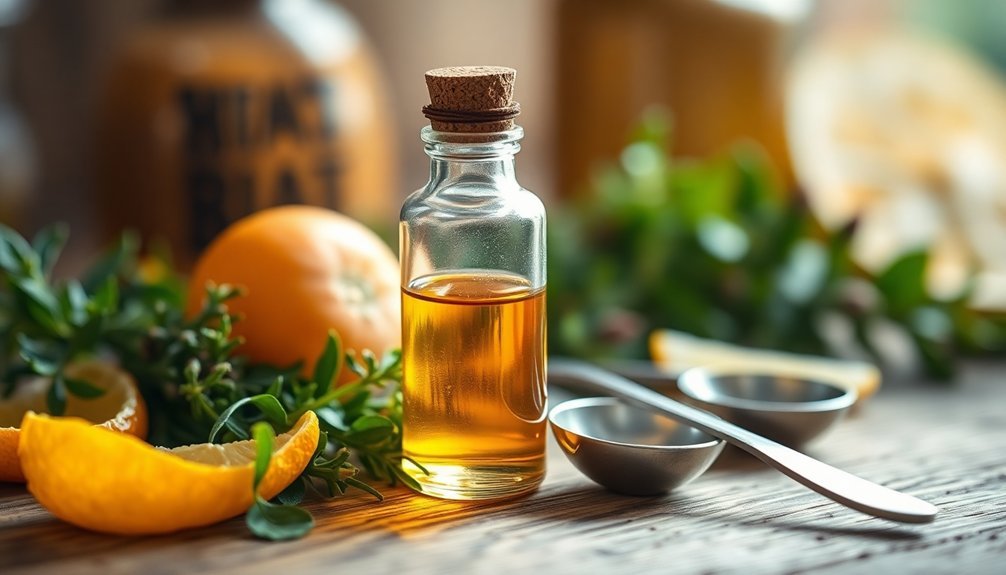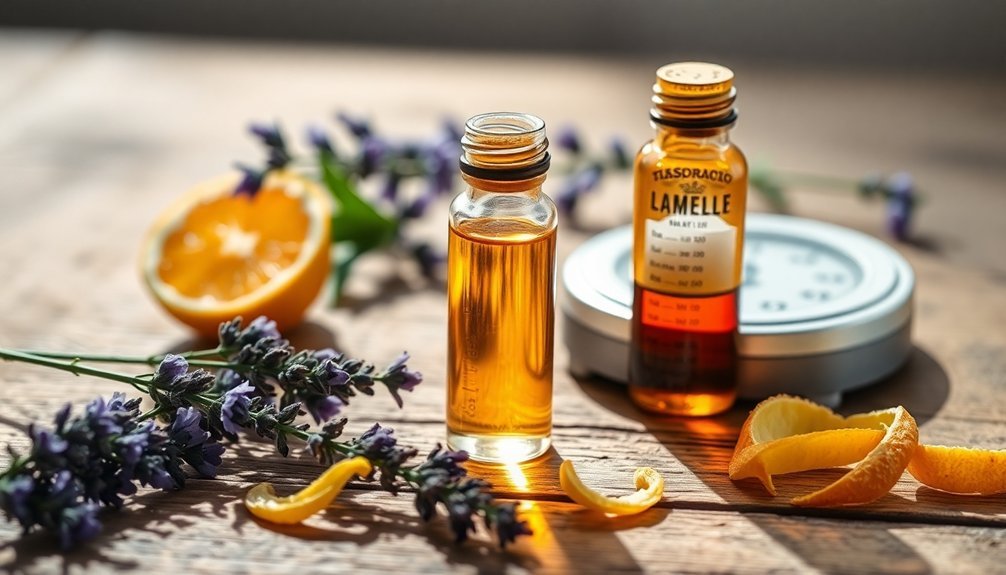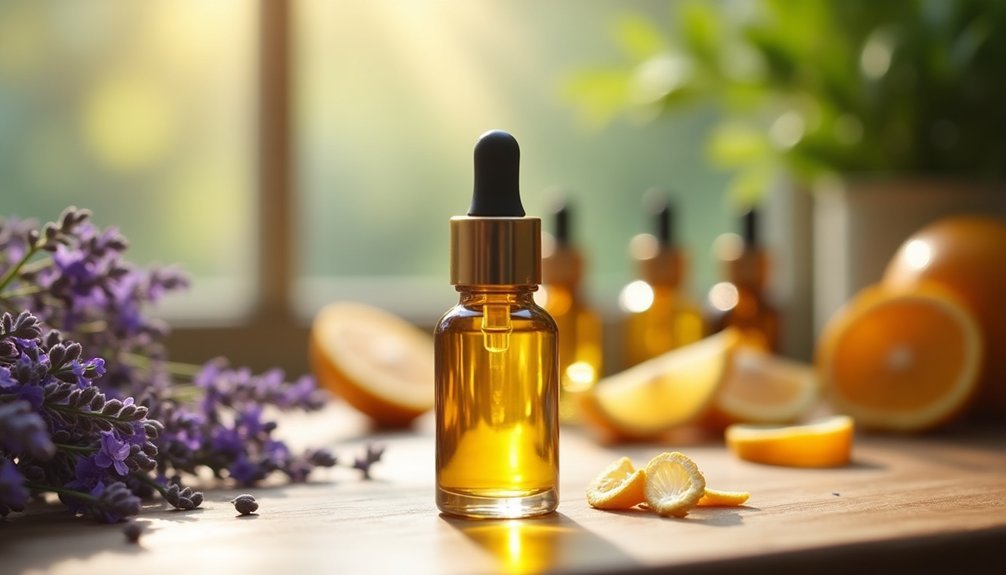To effectively preserve your homemade perfumes, combine 20-30% high-proof alcohol with natural fixatives like benzoin or Peru balsam. You'll want to add antioxidant-rich essential oils such as vetiver, frankincense, or myrrh to prevent oxidation. Store your blends in dark amber glass bottles at 60°F, away from sunlight and humidity. While vitamin E and rosemary oil help prevent fat oxidation, proper preservative ratios and storage techniques hold the key to lasting fragrance stability.
Understanding Natural Preservatives in Essential Oil Blends

Three key factors distinguish antioxidants from preservatives in essential oil blends.
First, while antioxidants like Vitamin E and Rosemary oil prevent fat oxidation and rancidity, they won't stop microbial growth.
Second, you'll need true preservatives for water-based perfumes, as antioxidants alone won't protect against bacteria, yeast, or mold.
For your perfume blends, you can opt for natural preservatives like 190-Proof Grain Alcohol at 20% concentration, which preserves your creation for up to 3 years. Making small batch productions ensures optimal freshness and safety of your blends.
If you're working with water-based perfumes, consider Leucidal Liquid (2-4%) or Potassium Sorbate for acidic formulations.
Don't rely on common misconceptions about Vitamin C or Citric Acid as preservatives – they're antioxidants that enhance stability but won't prevent microbial contamination.
Key Ingredients for Long-Lasting Perfume Stability
You'll find several natural powerhouses among essential oils that serve as excellent preservatives, including vetiver, frankincense, and myrrh, which help maintain your perfume's stability through their inherent molecular structures.
To prevent oxidation in your essential oil perfumes, you can incorporate antioxidant-rich fixatives like benzoin and Peru balsam, which form a protective barrier against environmental factors. The growing fragrance fixatives market demonstrates increasing demand for these natural preservation methods.
Strategic blending of these ingredients with carrier oils like jojoba creates a stable foundation that extends your perfume's shelf life while maintaining its intended fragrance profile.
Natural Preservative Powerhouses
Natural preservatives play an essential role in protecting perfume formulations, though not all options are equally effective.
While essential oils like tea tree and oregano offer some antimicrobial properties, they won't provide adequate wide-ranging protection on their own.
For reliable preservation, you'll want to take into account nature-identical preservatives like OptiphenTM BSB-W, which offers extensive protection against bacteria, yeast, and mold while meeting strict natural certification standards.
Alcohol can be an effective preservative when used at 20-30% concentration, and it's particularly useful in water-based perfumes as it helps solubilize essential oils. Regular product safety testing is recommended to ensure your perfume formulation maintains its protective properties over time.
Don't rely on controversial options like grapefruit seed extract or vitamin E, as they lack consistent antimicrobial effectiveness.
Instead, you can combine proven preservatives like Leucidal Liquid SF with AMTicide Coconut for enhanced protection against various microorganisms.
Oxidation Prevention Methods
While creating beautiful fragrances is an art, protecting them from oxidation requires scientific precision and proven techniques. You'll need to focus on proper storage, sealing methods, and smart ingredient choices to maintain your perfume's integrity.
| Prevention Method | Key Action |
|---|---|
| Storage Control | Keep bottles in cool, dry places away from bathrooms |
| Proper Sealing | Tighten caps immediately after use, check seals regularly |
| Fixative Usage | Add ambergris, musk, or synthetic stabilizers |
| Regular Maintenance | Monitor for degradation, perform occasional sprays |
Store your bottles upright and use them regularly to prevent stagnation in the dip tubes. Incorporate low-volatility molecules like patchouli and amber to enhance stability. When applying, opt for gentle misting rather than heavy spraying. Remember to layer similar notes at different evaporation rates for better scent continuity and increased longevity.
Step-by-Step Preservative Blend Formula

Creating an effective preservative blend involves four critical measurements and combinations.
You'll need to start with a 90/10 mixture of phenoxyethanol and ethylhexylglycerin as your base preservative system. Add this blend at 1% of your total formula weight.
Next, incorporate dehydroacetic acid and benzyl alcohol according to your formulation's specific requirements, ensuring even distribution throughout the mixture.
For additional protection, you can include 2 tablespoons of Everclear grain alcohol per cup of water to help bind essential oils and enhance longevity.
If you're seeking a natural alternative, add potassium sorbate at 0.1-0.3% concentration, but remember to adjust your formula's pH for ideal effectiveness.
Always mix your preservatives thoroughly and allow the blend to settle for 24-48 hours before use.
Proper Storage and Handling Methods
You'll want to store your essential oil preservative blends in dark amber or cobalt glass containers to protect them from harmful UV rays that can degrade the oils' quality.
The ideal storage temperature is around 60 degrees Fahrenheit, which helps maintain the chemical stability of your preservative blend and extends its shelf life.
Keep your containers in a cool, dark cabinet away from your bathroom, where temperature and humidity fluctuations can compromise the blend's effectiveness.
Dark Glass Container Benefits
Proper storage in dark glass containers serves as a critical defense against essential oil deterioration.
You'll find amber glass bottles offer superior protection against UV light damage, making them your best choice for preserving essential oils.
While green and cobalt blue glass bottles provide some protection, they're not as effective at blocking harmful UV rays.
- Amber glass provides maximum UV light protection for your essential oils
- Dark glass prevents photodegradation and maintains oil potency
- Airtight seals prevent oxidation and preserve oil quality
- Plastic containers should be avoided due to chemical reactions
- Proper storage extends the shelf life of your perfume blends
Keep your essential oils in a cool, dark place to complement the protective qualities of dark glass containers.
This simple yet effective storage method guarantees your perfume blends maintain their therapeutic and aromatic properties.
Temperature Control Essentials
When storing essential oils for perfume making, maintaining the right temperature is crucial for preserving their therapeutic properties and aromatic potency.
You'll want to keep your oils in a cool environment between 35-40°F (2-4°C) for ideal preservation.
Store your oils in ambient areas away from heat sources like stoves, radiators, and heating vents.
Don't place them near windows or in bathrooms and kitchens where humidity and temperature fluctuations can degrade their quality.
Instead, choose stable environments like cupboards or drawers.
If you're traveling with your oils, use leak-proof cases designed specifically for essential oil transport.
Remember to follow airline regulations for liquids and keep your oils protected from temperature extremes during transit.
You can refrigerate oils when necessary, though some may crystallize at lower temperatures.
Ideal Ratios and Measurements for Optimal Results

Creating the perfect essential oil blend requires precise measurements and ratios to assure proper solubilization and safety.
You'll need to carefully balance your solubilizer-to-oil ratios, typically ranging from 1:1 to 5:1, depending on the oils you're using. For citrus oils, opt for higher ratios of at least 3:1 to assure proper mixing.
- Use Polysorbate 20 at a 1:1 ratio for standard fragrance oils
- Choose Biosolv for natural, vegan-friendly formulations
- Keep essential oil concentration below 5% in carrier oils
- Mix solubilizer and oils separately before adding to base
- Start with small test batches to perfect your ratios
Remember to adjust your measurements based on the specific oils you're using.
Citrus and non-polar oils may require higher solubilizer ratios, while a combination of solubilizer and solvent can help reduce the overall ratio needed.
Signs of Perfume Degradation and Prevention
To protect your perfume investment and extend its longevity, you'll need to recognize early signs of degradation and take preventive measures. Watch for changes in smell, color, or clarity, and check if crystals form on the dispenser or sediments appear in the liquid.
Store your perfumes properly to prevent deterioration. Keep them in a cool, dark place away from heat sources and direct sunlight. Don't store them in your bathroom, where humidity can disrupt their chemistry.
Always guarantee the bottle is tightly sealed and avoid frequent opening to minimize oxygen exposure.
When using your perfume, keep your hands clean and don't let the nozzle touch your skin directly. Instead of shaking, gently roll the bottle to mix ingredients.
If you're making homemade perfumes, use dark glass bottles for better protection.
Essential Safety Guidelines for Preservative Use

Safe handling of preservatives in perfume-making requires strict adherence to established guidelines. You'll need to follow proper dilution ratios and use only high-quality essential oils from reputable vendors to guarantee your preservative blend remains safe and effective.
- Always perform an allergy test on a small patch of skin before incorporating new oils.
- Store your preservative blends in child-proof containers away from direct sunlight.
- Verify the chemical specifications and constituent levels of each essential oil.
- Use only 100% pure, undiluted oils free from fillers and synthetic additives.
- Check the botanical name and extraction method to confirm authenticity.
Remember to monitor the concentration levels of your preservative blend carefully, especially when creating perfumes for vulnerable individuals.
Keep detailed records of your formulations and maintain proper storage conditions to prevent degradation of your preservative components.
Frequently Asked Questions
Can I Use Synthetic Preservatives Alongside Natural Ones in My Perfume Blend?
Yes, you can combine synthetic and natural preservatives in your perfume. You'll get enhanced stability and broad-spectrum protection, but you'll need to carefully check for compatibility issues between the different preservative types.
How Do Different Climate Conditions Affect Preservative Effectiveness in Essential Oils?
You'll find that high temperatures, humidity, and light exposure reduce your essential oils' preservative power. In warmer climates, you'll need stronger preservation methods, while cooler, drier conditions help maintain their effectiveness.
Are There Specific Essential Oils That Should Never Be Mixed With Preservatives?
You shouldn't mix citrus oils like lemon and bergamot with synthetic preservatives, as they'll increase skin sensitivity. Tea tree and eucalyptus oils can also react negatively with parabens and phenoxyethanol.
Do Preservatives Alter the Therapeutic Properties of Essential Oils?
Yes, preservatives can alter your essential oils' therapeutic properties. They'll interact with active constituents, potentially changing their effectiveness. You'll notice impacts on antimicrobial activity, stability, and therapeutic benefits of your oils over time.
What's the Shelf Life Difference Between Preserved and Unpreserved Essential Oil Blends?
You'll find preserved essential oil blends typically last 3-5 years, while unpreserved ones may only last 6-12 months. Proper storage in dark bottles and cool temperatures is vital for both types.
In Summary
Creating your own essential oil preservative blend isn't difficult once you've mastered the basics. Remember to always use clean containers, store your perfumes properly, and follow the recommended ratios for preservatives. You'll know you're successful when your homemade perfumes maintain their scent and stability for months. With consistent attention to safety guidelines and proper handling, you'll enjoy long-lasting, naturally preserved fragrances.





Leave a Reply